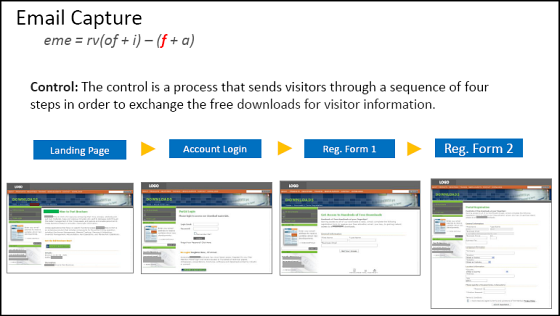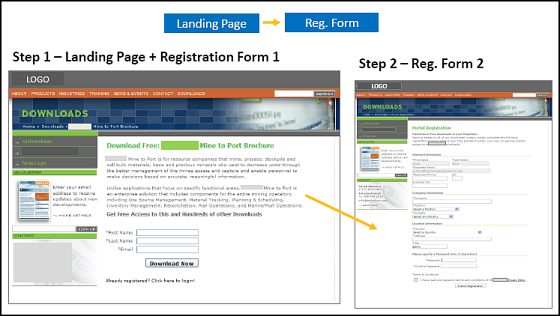If you ask anything of a customer you must make it worth it for them to give it to you. This applies to every step in the sales process, right from the very beginning.
This is the conclusion that MECLABS, the parent company of MarketingExperiments, came to after studying more than 20,000 sales paths over 15 years. Of those sales paths, the latest MarketingExperiments Web clinic reviewed nine that focused on email capture. Here’s what we discovered: small changes that help customers perceive that it’s worth their time, effort and risk to provide you their information increased email capture from 21% to more than 600%. Watch it here.
Here’s one of the tests.
Background: The partner has an email capture process that offers downloadable reports in exchange for information. They wanted to capture and qualify emails.
Goal: Increase number of form submissions.
Primary research question: Which process will get the most submissions?
Approach: Adapt the registration process to reduce friction (friction is anything that makes the customer work harder to get through the sales process)
The Control was loaded with friction. It forced visitors to take four steps to access the reports.
The Treatment reduced those steps, but changed nothing else.
The result was that 364% more visitors submitted their email address to download reports.
Why was there nearly a four-fold increase in email capture?
The Treatment did not cost the visitor too much time to go through the process. They perceived that it was worth taking two steps to get access to the reports. However, the Control was perceived as too costly — visitors thought it wasn’t worth their time and effort to go through four steps to get access to the reports.
Everything we ask of customers is a transaction; closing the deal is the culmination of a long series of transactions. At any step of the sales process, if customers think that what they’re asked to do costs more than what they’ll receive for doing it, they’ll walk away. That’s why it’s critical to apply these three principles when you ask customers for their email — or anything else for that matter.
Principle #1
Any action we want our visitor to take, even a non-monetary one like giving an email address, comes with a perceived cost. Reduce the implicit cost associated with the request.
Principle #2
Tell customers why you’re asking. Communicate a strong process-level value proposition that answers the question, “If I am your ideal customer, why should I give you my email address?”
Principle #3
Perceived cost — whether that’s money, time, risk or resources — can be positive. Here’s why: marketers can use it to control the size and quality of email lists. In essence, if you want more qualified leads, ask the prospect to do more. The more prospects want what you’re selling, the more likely they’ll do what you ask.
You might also like
Email Marketing: Top 5 most effective list growth tactics
Lead Generation: How to build your own list [From the MarketingSherpa blog]
Lead Generation: Content and email combine for high-quality list building [From MarketingSherpa]
MarketingSherpa Summit 2016 — At the Bellagio in Las Vegas, Feburary 22-24 (MarketingSherpa is the sister company of MarketingExperiments)







Principle #2 – “If I am your ideal customer, why should I give you my email address?”
Is one that I find is almost always overlooked. Very few sites tell you why they want an email address. And if they DO think they are telling you, it boils down to … To get updates. Lol, who wants those?
Anyways …
Thanks. I gobble up any “reveals” you guys give.